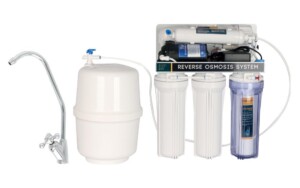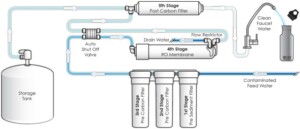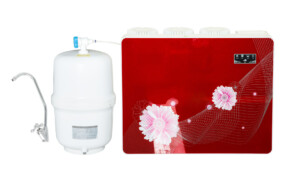What is Reverse Osmosis?
Reverse osmosis removes pollutants from unfiltered water when water passes through the semi-permeable membrane. Clean drinking water is produced by moving water across a RO membrane from one side, which is more concentrated and has more impurities, to the other, which is less concentrated and has less contaminants.

Stages of RO Systems
RO systems are made up of 3, 4, 5, or 7 stages of filtration.
Each type of system contains one or more of the following filters:
- Sediment filter: Reduces particles like dirt, dust, and rust
- Carbon filter: Reduces volatile organic compounds (VOCs), chlorine, and other contaminants that give water a bad taste or odor
- Semi-permeable membrane: Removes up to 98% of total dissolved solids (TDS)
5 Stage Water Purifier

When water first enters an RO system, it goes through pre-filtration which includes a sediment filter and a carbon filter to remove chlorine or sediment that could clog the RO membrane.
After pre-filtration, the water goes through the RO membrane where dissolved tiny particles are removed. Next, water flows to the storage tank until its full. Once drinking faucet is turned on, the water goes through the post-filtration process to polish drinking water before it reaches the faucet.
7 Stage Water Purifier

7 Stage water purifier is the most advanced domestic mineral water purifier available combining state of the art technologies including Reverse Osmosis, Ultraviolet Light Sterilization, Mineralization, and pH balancing that previously was only found in mineral water bottling production to produce safe, refreshing, and good tasting water. The treatment process includes: –
Stage 1 – Sediment cartridge
Stage 2 – Activated Carbon cartridge
Stage 3 – Carbon Block cartridge
Stage 4 – Reverse Osmosis membrane
Stage 5 – Carbon Rinse cartridge
Stage 6 – Mineralizer cartridge
Stage 7 – UV treatment
Benefits of an RO System
Reverse osmosis systems remove 98% of dissolved solids which makes the water healthier to consume.
- Fits under the kitchen sink
- Better for the environment than bottled water
- Reduces sodium levels
- Reduces harmful dissolved pollutants
- Simple to install and maintain
- Removes unpleasant flavors and scents

How Long do Reverse Osmosis Systems Last?
Systems for reverse osmosis typically last 10 to 15 years. The RO membrane and filters need to be replaced from time to time, even if the systems themselves have a lengthy lifespan. Every six months to a year, the prefilters and postfilters should be changed. The RO membrane needs to be changed every 2-4 years, depending on your water’s quality.
